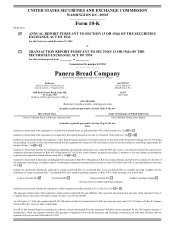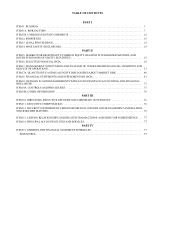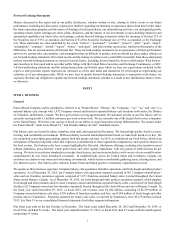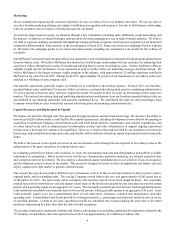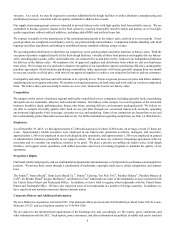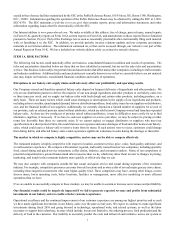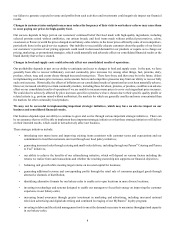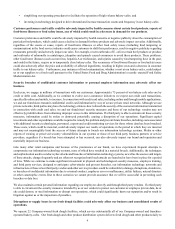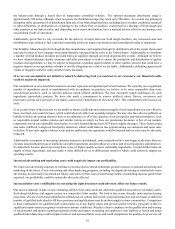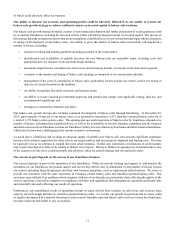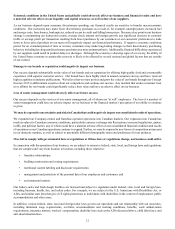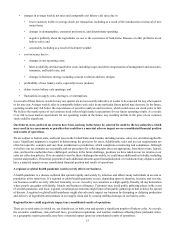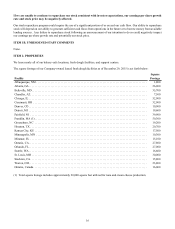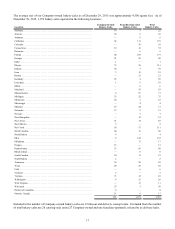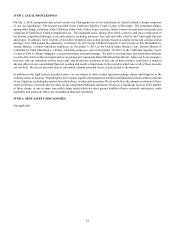Panera Bread 2015 Annual Report Download - page 18
Download and view the complete annual report
Please find page 18 of the 2015 Panera Bread annual report below. You can navigate through the pages in the report by either clicking on the pages listed below, or by using the keyword search tool below to find specific information within the annual report.8
our failure to generate expected revenue and profits from such activities and investments could negatively impact our financial
results.
Changes in customer tastes and preferences may reduce the frequency of their visits to our bakery-cafes or may cause them
to cease paying our prices for high-quality food.
Our success depends in large part on our customers' continued belief that food made with high-quality ingredients, including
selected proteins raised without antibiotics, our artisan breads, and food items made without artificial preservatives, colors,
sweeteners or flavors is worth the prices charged at our bakery-cafes relative to the lower prices offered by some of our competitors,
particularly those in the quick-service segment. Our inability to successfully educate customers about the quality of our food or
our customers’ rejection of our pricing approach could result in decreased demand for our products or require us to change our
pricing, marketing, or promotional strategies, which could materially and adversely affect our consolidated financial results or the
brand identity that we have created.
Changes in food and supply costs could adversely affect our consolidated results of operations.
Our profitability depends in part on our ability to anticipate and react to changes in food and supply costs. In the past, we have
generally been able to recover inflationary cost and commodity price increases for, among other things, fuel, proteins, dairy,
produce, wheat, tuna, and cream cheese through increased menu prices. There have been, and there may be in the future, delays
in implementing such menu price increases, and economic factors and competitive pressures may limit our ability to recover fully
such cost increases. Historically, the effects of inflation on our consolidated results of operations have not been materially adverse.
However, increased volatility in certain commodity markets, including those for wheat, proteins, or produce, could have an adverse
effect on our consolidated results of operations if we are unable to increase menu prices to cover such ingredient price increases.
We could also be adversely affected by price increases specific to proteins we have chosen due to their specific quality profile or
related criteria (e.g. proteins raised without antibiotics), the markets for which are generally smaller and more concentrated than
the markets for other commodity food products.
We may not be successful in implementing important strategic initiatives, which may have an adverse impact on our
business and consolidated financial results.
Our business depends upon our ability to continue to grow and evolve through various important strategic initiatives. There can
be no assurance that we will be able to implement these important strategic initiatives or that these strategic initiatives will deliver
on their intended results, which could in turn adversely affect our business.
These strategic initiatives include:
• introducing new menu items and improving existing items consistent with customer tastes and expectations and our
commitment to food that customers can trust through our food policy initiatives;
• generating increased sales through catering and small order delivery, including through our Panera® Catering and Panera
to You® initiatives;
• our ability to achieve the benefits of our refranchising initiative, which will depend on various factors including the
returns we realize from such transactions and whether the resulting ownership mix supports our financial objectives;
• balancing unit growth while meeting target returns on invested capital for locations;
• generating additional revenue and corresponding profits through the retail sale of consumer packaged goods through
alternative channels of distribution;
• identifying alternative formats for our bakery-cafes to enable us to open locations in more diverse locations;
• investing in technology and systems designed to enable our managers to focus their energy on improving the customer
experience in our bakery-cafes;
• increasing brand awareness through greater investment in marketing and advertising, including increased national
television advertising and digital advertising and continued leveraging of our MyPanera® loyalty program;
• investing in labor and the related management tools to meet the demands necessary to maximize throughput and capacity
in our bakery-cafes;



